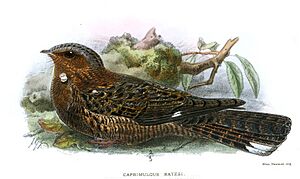Bates's nightjar facts for kids
Quick facts for kids Bates's nightjar |
|
|---|---|
 |
|
| Conservation status | |
| Scientific classification |
The Bates's nightjar (Caprimulgus batesi), also known as the forest nightjar, is a fascinating bird. It belongs to the Caprimulgidae family. You can find this bird living in the rainforests of western Sub-Saharan Africa.
Contents
What Bates's Nightjar Looks Like
Bates's nightjar is a large, dark bird. When it rests, it looks like it has a big head and a long tail. Its back and wing feathers are dark brown. They have black and buff streaks and spots. There is often a light buff collar on its neck. This collar can be hard to see on some birds.
Its belly is blackish-brown. It has buff speckles on its chest. These speckles turn into bars on its lower belly. Its throat is a whitish color.
When the male flies, you can see a small white spot near its wingtip. It also has white tips on its two outer tail feathers. The female is lighter in color. She does not have white spots on her wings or tail. These birds are about 29–31 cm (11–12 inches) long. They weigh between 89 and 112 grams (3.1–4 ounces).
The Nightjar's Call
The song of Bates's nightjar is loud. It sounds like "whow whowwhowwhowwhow". After the first "whow," there is a short pause. Then, a series of repeated notes follows.
Where Bates's Nightjar Lives
Bates's nightjar lives in different areas. One group lives in southern Cameroon. Another group is found in western Cameroon, Gabon, southern Central African Republic, and western Congo. A third group is slightly separate in the western Congo.
There is another population in eastern Congo. This group also lives in the north-western Democratic Republic of the Congo. A fifth group lives across the Democratic Republic of the Congo. It extends into eastern Uganda in the Bwamba Forest. The last group is in the central Democratic Republic of the Congo.
Bates's Nightjar's Home
Bates's nightjar mainly lives in lowland primary rainforests. It likes clearings and the edges of forests. It can often be found near water, especially by rivers or in flooded forests. You might also see it in secondary forests. These are forests that have grown back after being cut down. It also lives in plantations that are close to primary rainforests.
How Bates's Nightjar Behaves
Like most nightjars, Bates's nightjar is active at dusk and night. This means it is a crepuscular and nocturnal bird. It rests on the ground in clearings or on paths. Sometimes, it perches several meters up on a climbing plant called a liana.
It hunts for food over and within the forest canopy. It also hunts over clearings and along the edges of river forests. It eats insects like mantises, crickets, grasshoppers, beetles, and moths.
Bates's nightjar does not build a nest. It lays a single egg directly on the bare ground. Sometimes, it lays the egg among fallen leaves. Nest sites are sometimes found on paths or trails. The breeding season is from December to January in Gabon. In the Democratic Republic of Congo, they might breed all year round.


